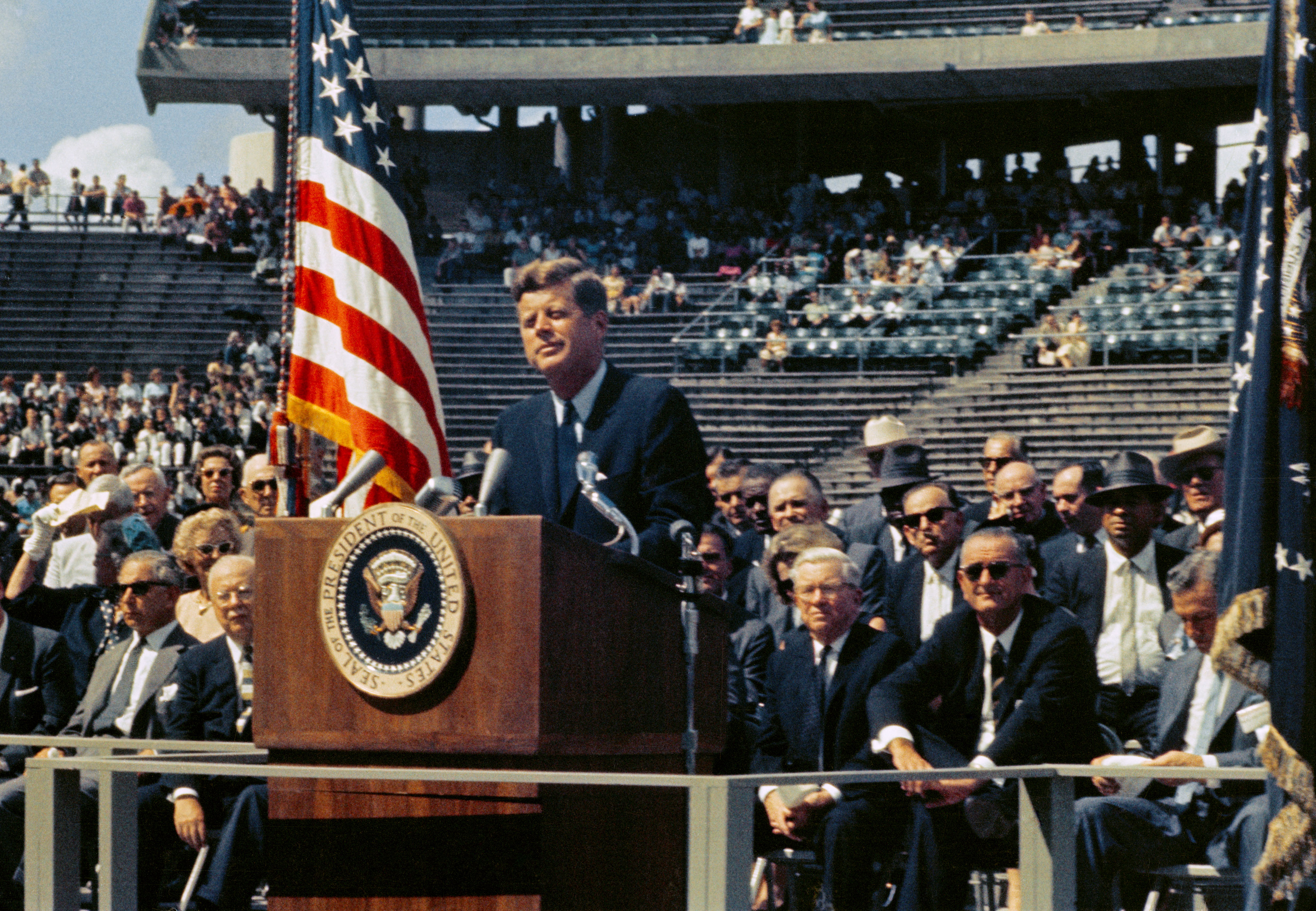
One of the things we realized last season is that we focused too much on satellites and launches in the history segment and ended up talking about eleventy billion slightly different space shuttle missions. There’s a lot more space history to cover. This week’s segment of This Week in Space History will be about significant presidential space policy speeches, and future segments will feature important people and significant events.
An example of “significant space policy speeches” is President Kennedy’s “we choose to go to the Moon” speech, which happened this coming week in 1962.
On September 12, 1962, at Rice University near Houston, Texas, President Kennedy informed the public at large that the United States was finally going to win the Space Race by putting a man on the Moon. This was right at the highest point of the Cold War when the U.S. and the Soviet Union were aiming nuclear weapons at each other and waiting for the other side to blink in the Cuban Missile Crisis. The Space Race was a less violent way for the two nations to compete, though the origins of satellite launch began with the very same missiles, just lacking nuclear warheads.
Both the United States and the Soviet Union came up with novel ways to one-up each other: first to orbit, first to fly by another planet, etc. The ultimate goal, at least from the U.S.’s perspective, was to land a human on the Moon and return him to Earth. (As a reminder, the first American woman wouldn’t go to space until 1983.) Up until that point, the Soviets had been the first to hit most major milestones. President Kennedy’s ambitious goal gave Americans something positive to look forward to, instead of the potentially apocalyptic conflict.

While the most important topic of President Kennedy’s speech was the lunar program announcement, he also had to win over the American people. Much of the framing of the speech talks about humanity’s history of exploration and science, and how America specifically contributed to it. He also addressed criticism of the proposal, since you couldn’t get away from people complaining about the cost of the space program and how it would benefit them even when it was a pure Cold War propaganda machine.
The quote “we choose to go to the moon and do the other things not because they are easy but because they are hard…” is what the speech is best remembered for. After Kennedy was assassinated a year later, the program was given new importance and successfully completed just in time for his deadline with the landing of Apollo 11 on July 20, 1969.
Kennedy wasn’t the only president to make space policy a major part of his administration. Several others did as well and announced their programs with speeches, such as George H. W. Bush on July 20, 1989.
President Bush Sr. presented his Space Exploration Initiative to the nation, a program where NASA would build a space station in Earth orbit, send humans back to the Moon in a more permanent fashion, and from there go on to Mars. Sound like Artemis? Sadly, nearly the entire program was canceled in 1993 because of cost. The space station, originally called Freedom, only survived because of its incorporation into the ISS program with Russia and others after the fall of the Soviet Union in 1991.

The next major presidential space policy speech was given by President George W. Bush (Bush 43) on January 14, 2004. President Bush Jr announced the Vision for Space Exploration. The Constellation program, NASA’s implementation of this policy, planned to return humans to the Moon as a stepping stone to Mars, using shuttle-derived rockets called Ares I and V.
Constellation was canceled in 2009 by Barack Obama but not really. The same contracts and everything were kept, turning what the design had morphed into at the very end of the Constellation program into the modern Space Launch System. That rocket, after a long development program, is currently sitting on the pad at 39B under a different name, Artemis.
Perhaps the most significant space policy speech was given by a Vice President, not the sitting president. On March 26, 2019, during a meeting of the National Space Council, Vice President Pence formally announced the Artemis program with the goal of putting the “first woman and next man” on the Moon in 2024 — much earlier than the previous goal of 2028. The Artemis program would use the existing SLS rocket and Orion spacecraft first conceived of in the Constellation program. The difference between this attempt and all the others that came before was designed sustainability. Artemis would have a space station in orbit of the Moon to allow repeated landings and longer stays in lunar orbit. Artemis also involves commercial companies in several aspects, from cargo resupply of the space station to the crewed lander itself.
More Information
Address at Rice Univesity on the Nation’s Space Effort (JFK Presidential Library and Museum)
US to Return Astronauts to the Moon by 2024, VP Pence Says (Space.com)




 Join the Crew!
Join the Crew!
 Escape Velocity Space News
Escape Velocity Space News
0 Comments